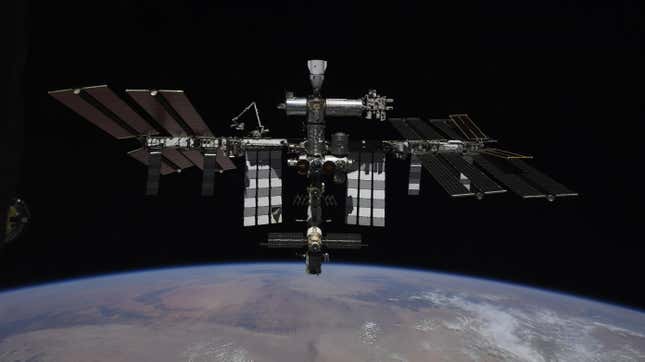
All seven astronauts currently aboard the International Space Station are having to take shelter inside their respective spacecraft owing to the sudden appearance of a debris cloud in orbit. The U.S. State Department says the fragments were produced by a Russian anti-satellite missile test.
Information is slowly trickling in, but we do know that the ISS is currently functioning normally and that all seven crew members are healthy and safe. The crew had to take shelter earlier this morning after the breakup of the defunct satellite Kosmos-1408, which was hit as part of a Russian anti-satellite weapons test, said Ned Price, a spokesperson for the U.S. State Department, at a press briefing held this afternoon. Price said the U.S. is tracking around 1,500 pieces of debris but that many thousands of untraceable smaller fragments were likely produced as well.
NASA astronauts Raja Chari, Tom Marshburn, Kayla Barron, and ESA astronaut Matthias Maurer are sheltering inside a SpaceX Crew Dragon docked to the ISS, while Russian cosmonauts Anton Shkaplerov, Pyotr Dubrov, and NASA astronaut Mark Vande Hei are inside a Soyuz capsule, reports Russian state-owned news agency TASS. The astronauts could use these spacecraft to safely return to Earth in the event the ISS is damaged by the debris.
A live feed of NASA mission control audio is available, along with live video of the ISS.
The crew was instructed to close the hatches between the U.S. and Russian segments as well as radial hatches that seal off several modules, including ESA’s Columbus module, as CBS reports, adding that the radial hatches might have to stay closed for an entire day.
In a tweet, Roscosmos said the crew is “routinely performing operations according to the flight program,” and that the threatening “object” has “moved away from the ISS orbit.” By “object,” the Russian space agency is referring to the debris field. The “station is in the green zone,” Roscosmos added. “Friends, everything is regular with us!,” tweeted Shkaplerov. “We continue to work on the program.”
Despite these words of reassurance, operations aboard the ISS are most certainly not back to normal. Mission controllers are continually providing countdowns of each debris field transit (i.e. the closest approach of the debris field to the ISS). At 10:32 a.m. ET, controllers provided instructions for the NASA crew to temporarily enter into the Columbus module to perform some quick tasks and to collect personal items should they have to remain inside Dragon overnight (a possible indication that this could take a while).
The debris field transits are happening about once every 93 minutes. In an email, Harvard University astrophysicist Jonathan McDowell said that, assuming it’s a debris field caused by a broken-up satellite, “there will be a big error bar on whether there is risk to ISS, hence the caution.”
U.S. Space Force “is aware of a debris-generating event in outer space” and is “working to characterize the debris field and will continue to ensure all space-faring nations have the information necessary to maneuver satellites if impacted,” tweeted space reporter Joey Roulette from the New York Times.
In a tweet, Seradata, a company responsible for maintaining the SpaceTrak launch and satellite database, says Kosmos-1408's orbit was “a bit higher than ISS but not much,” adding that the presumed ASAT strike on the satellite “would cause some debris to be fired below it...threatening ISS with a crossing debris cloud.”
Data gathered by space debris tracking company LeoLabs shows “at least 30 unique objects detected near expected location” of the Russian satellite. McDowell expects “thousands of pieces of cataloged debris from a satellite the size of Kosmos-1408,” as satellites of this type weigh roughly 3,860 pounds (1,750 kg), as he pointed out in a tweet, adding that “it may take days to weeks for the first debris objects to be cataloged and years from them all to be located.”
Today’s incident comes less than a week after the ISS had to make an emergency maneuver to evade potentially threatening space junk. In that case, it was a remnant of the Fengyun-1C weather satellite, which China deliberately destroyed in 2007 as part of an anti-satellite missile test. India did something similar in 2019, joining the United States, Russia, and China as countries that have tested anti-satellite weapons. Currently, the use of ASATs “occupy a gray zone” when it comes to international arms control, writes Talia M. Blatt from Harvard University.
This is a developing story and we will update this article as we learn more.